Use these tips to write an effective hotel COVID-19 safety measure statement. (With examples!)
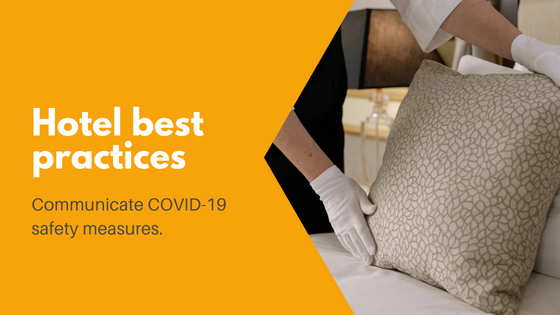
Tips for hoteliers: How to write a hotel COVID-19 safety notice
Hurrah! The summer of revenge travel is finally here—hoteliers can finally breathe a collective sigh of relief as occupancy levels return to normal (or near-normal) levels.
Real talk: It’s been many months of waiting for the day to come that guests would willingly return to your property—for fun, for work, for a break, not for quarantine purposes.
But it wasn’t easy getting here! We needed vaccines. We needed borders to re-open. We also needed to alleviate guests’ COVID-19-related anxieties. That is, you needed to communicate what your hotel was doing to keep guests safe from COVID-19 while staying at your property.
By now, you will have already published a hotel COVID-19 safety notice on your website; you’ve also emailed your subscribers with the details of your hygiene and safety protocols. But for the few that haven’t done so yet, or for those that need a refresher, keep reading. You’ll find easy-to-follow tips and real examples from around the world to inspire you!
This post was originally published in October 2020.
Benefits of communicating your hotel’s COVID-19 safety measures with guests
One way to lower a potential guest’s anxiety is by sharing your hotel’s COVID-19 safety measures. Failing to do so may give the impression you’re not doing anything—or that you don’t care. You don’t want either; such perceptions are bad for business. But that’s not the only reason for publishing your COVID-19 safety measures. Let’s take a closer look at the most compelling reasons to outline your hotel’s health and safety precautions.
✅ It boosts confidence in your brand
To put it quite simply, which hotel would you rather book: The one whose website makes it appear like it’s business as usual or the one that’s transparent, actively sharing what they’re doing to keep you and your loved ones safe?
I bet you didn’t have to put much thought into it. You’ll choose the one that’s proactive about health and safety measures.
Frankly, your potential guest don’t necessarily know what steps you’re taking. That’s why it’s important to announce what you’re actually doing. Don’t leave it up to a potential guest’s imagination – be up front about the measures you’ve put in place.
Takeaway: During these high-anxiety times, everyone wants (and needs) reassurance before they commit to a booking. Give it to them!
✅ It’s an opportunity to rank highly on search engines
Under normal circumstances, it’s extremely challenging to land your hotel’s website on the first, second, or even third pages of search engines. After all, you’re competing against online travel agency and hotel aggregator heavyweights like Booking.com and TripAdvisor. But creating a page that addresses health and safety measures is a great way to actually land your brand high up on search engine results pages—and land direct bookings!
Here’s an example of a search I ran for hotels in London:
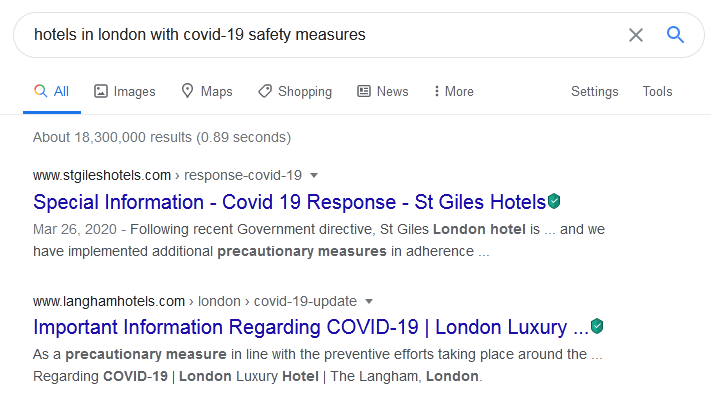
And one for Bangkok:
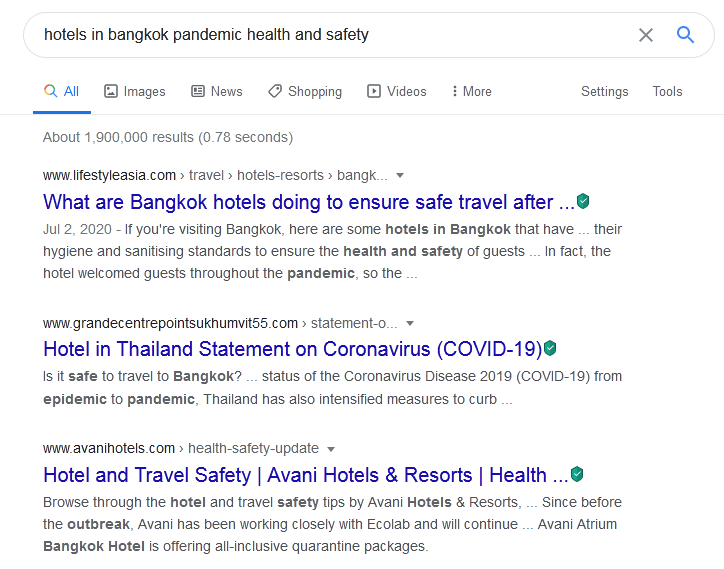
Prospects with concerns about health and safety during travels (or considering a hotel staycation) can easily find your website this way. That’s an advantage you have over competitors. And it gets you one step closer to securing that valuable reservation.
Takeaway: It’s a great way to land in front of – and capture – the attention of cautious travelers with specific searches related to health and safety.
✅ You’re showing clients that you care
As mentioned at the start of this post, you don’t want people to think that you aren’t doing anything—or that you don’t care about guests’ well-being.
Perhaps you feel like you aren’t doing quite enough worth mentioning. After all, it’s not like you’ve partnered with Johns Hopkins or other organizations to craft your COVID-19 response. And maybe you aren’t able to harness the latest and greatest technology can offer for a truly contact-less experience. That doesn’t matter because you’re still doing something about health and safety behind the scenes. Whatever it is, it’s important that you communicate those efforts. You want your stakeholders to know that you’re doing everything you can to keep them safe.
Takeaway: A COVID-19 safety notice is especially important for small or independent hotels. After all, you don’t necessarily have the big chain name (and the reputation that comes with it) to get customers through the front door.
Can’t I just leave it to the tourism or health authorities?
You could… but why rely on others?
First of all, prospects won’t necessarily go to a foreign country’s tourism or health authority’s website to check what measures are in place over there.
Second, it’s one thing for the destination country’s authorities to talk about what they’ve mandated hotels to do and another entirely for you to put it into perspective on a micro level. That is, how those measures take shape at your property.
Having said all that, there’s only so much you can do to convince travelers that it’s safe to stay at your hotel. This is because the perception of safety will also be influenced by your country’s national response to the virus – that’s something you don’t have direct control over.
In other words, if your country is deemed to have had a poor response to the pandemic or continues to see rising cases of COVID-19, it’s going to be much harder to persuade anyone to travel to your destination let alone that your hotel is safe. (You don’t exist in a bubble; you’re part of the community.)
A dedicated page to your hotel’s COVID-19 response shows, at the very least, that you’re taking the situation seriously.
2021 Update: Still think that your brand can’t get away without talking about your health and safety measures? Booking.com’s recent research found that 70% of people “will only book if they know which health and hygiene policies are in place”. Don’t throw opportunities for bookings away! If you haven’t already done so, start writing your safety measures information now!
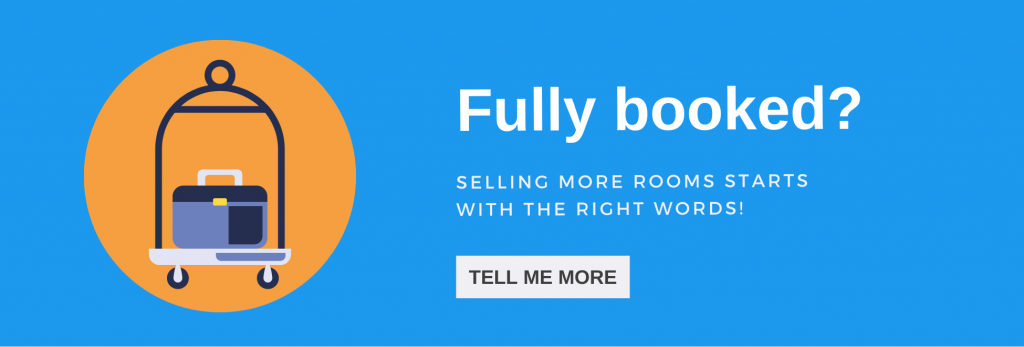
Examples: Here’s how hotels are sharing their COVID-19 safety measures
Now that you’re decided on addressing your hotel’s COVID-19 response, the question is what’s the best way to actually talk about it? After all, you don’t want to go overboard (and stoke more fears). At the same time, you don’t want to sound halfhearted.
These 7 examples from around the world show you the different ways hotels are communicating their COVID-19 safeguards—and what you can learn from them.
Hotel Balzac: COVID-19 safety measures & responses
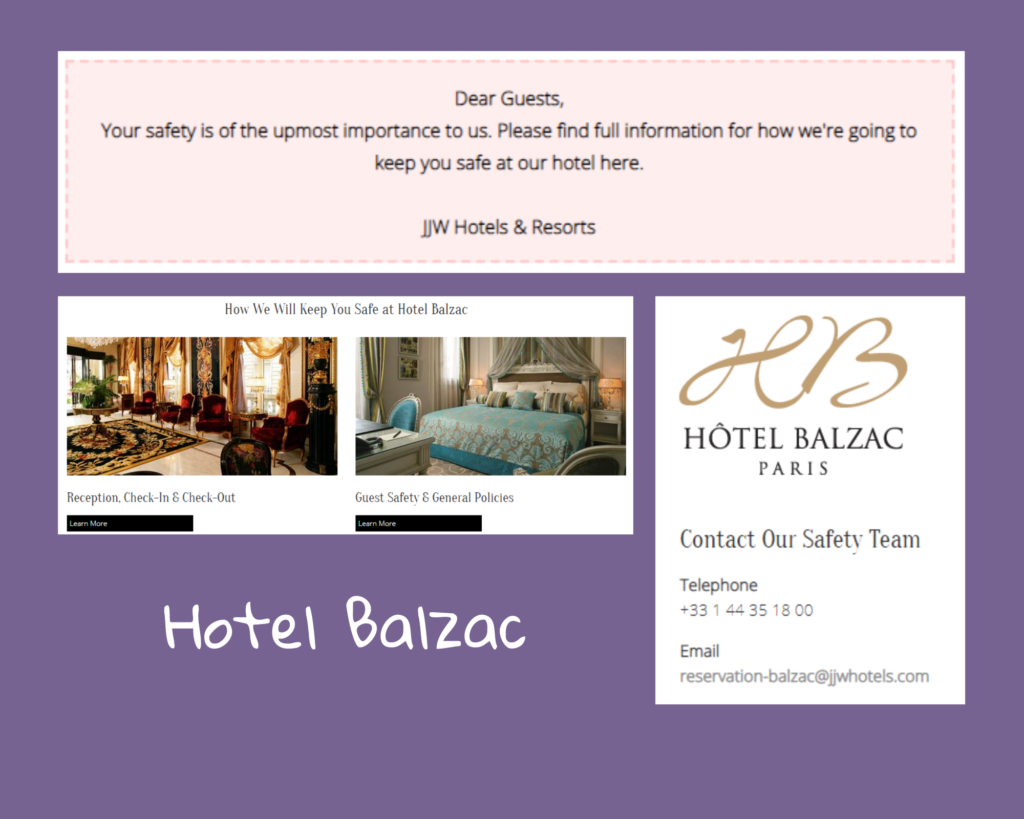
- The message should have a prominent position on your homepage. That makes it easy for potential guests to quickly access safety information.
- Use active voice. It exudes confidence. Combined with the future tense, the wording makes the reader feel like they’ve already decided on this place. That feeling could provide the much-needed push to actually go ahead with a booking.
- Encourage them to contact you. This shows transparency; you are prepared and willing to answer safety concerns pre-booking. Also, personal contact opens up an added opportunity to convert leads.
Okura Nikko Hotels: Clean & Safe Stay
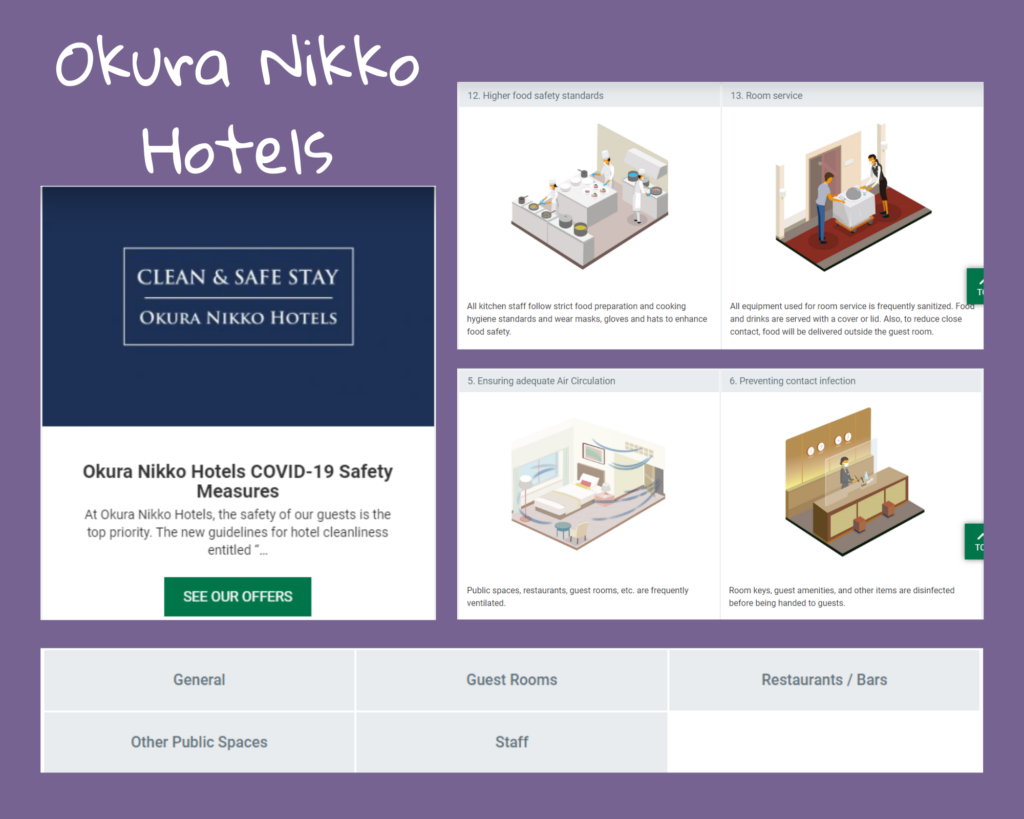
- Link to more detailed information. Provide a quick overview on the homepage and then redirect readers to another page for further information.
- Break safety measures down by category. That makes it easier for people to find specific information they’re looking for – whether that’s guest room safety or measures taken in shared spaces.
- Complement descriptions with clear imagery. That makes it easier to understand and visualize efforts. It’s also helpful for non-English speakers.
First Hotels: Stay safe at First Hotels
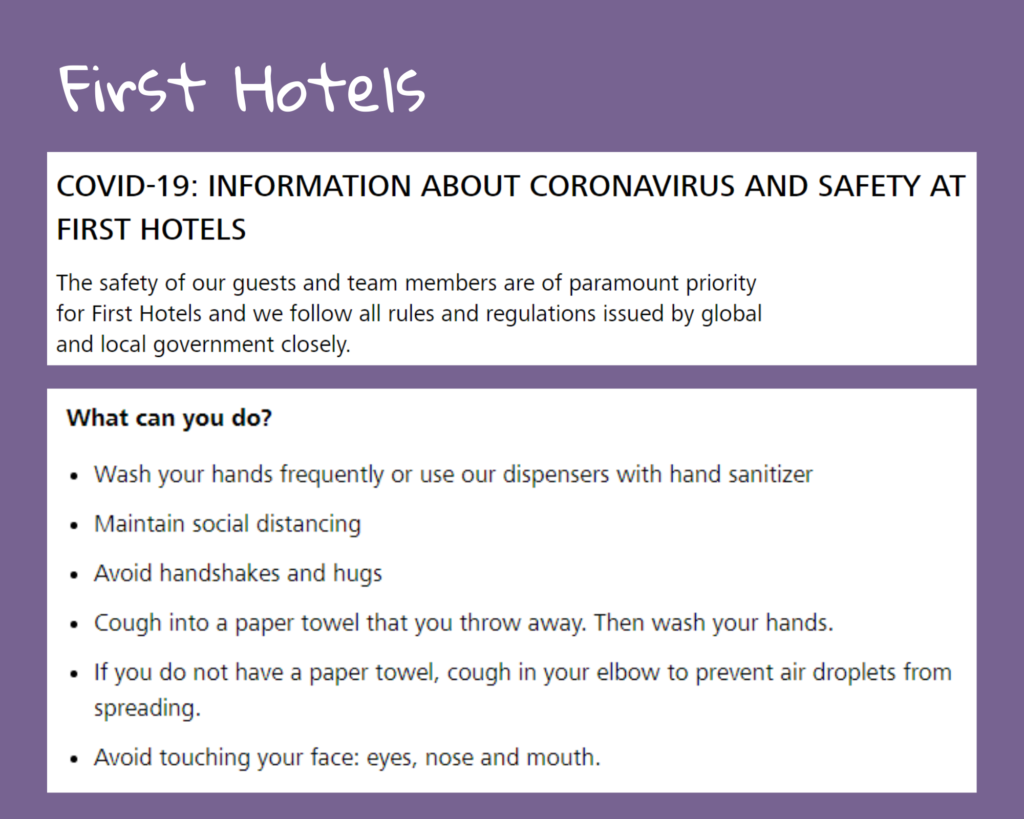
- Have clear and specific headlines. Don’t confuse your readers.
- Involve your guest. Encourage positive behavior. After all, it isn’t just about what you’re doing to keep them safe – well-being is a joint effort.
- Reference best practices. Efforts should come across as well-thought out and in adherence with best practices. Mention that you’re following local (e.g. CDC) and or international health and safety guidelines (e.g. WHO).
Scandic Hotels: #StaySafe at Scandic
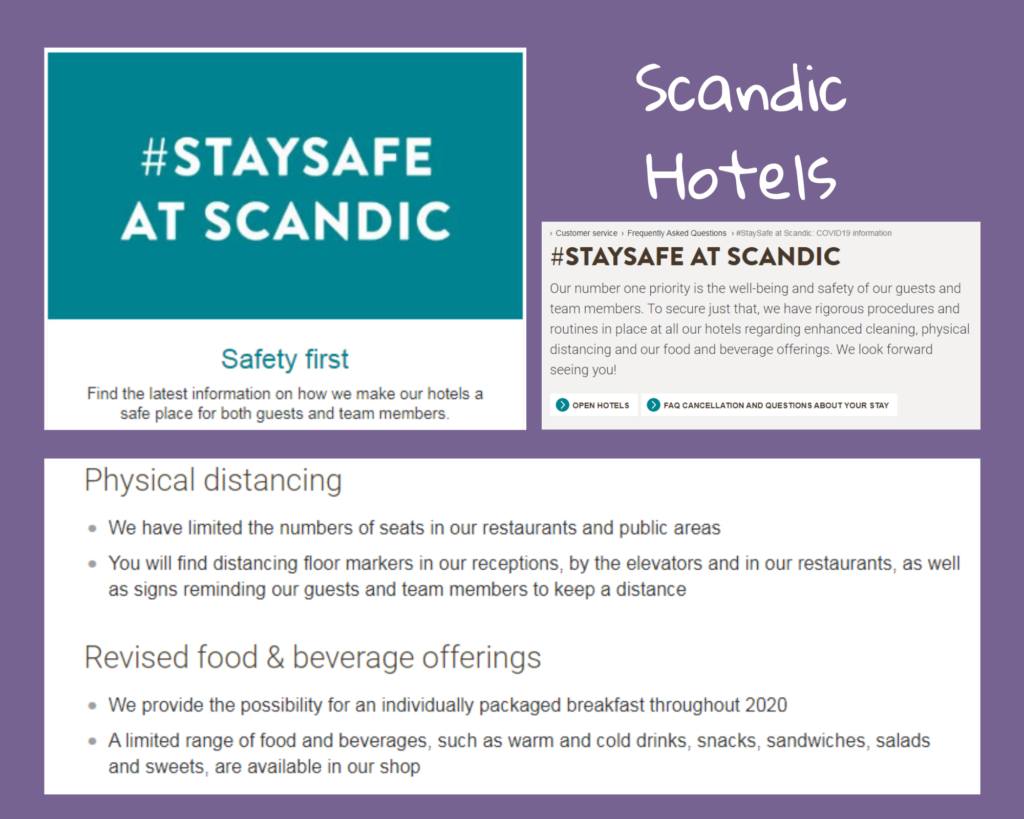
- Reference relevant hashtags. Hashtags can be an additional source of information and open up additional resources for would-be guests – especially if your client-base are social medial users.
- Use bullet points in your hotel COVID-19 notice. That makes your information more reader-friendly and easier to digest.
- Update information as necessary. This entire situation is dynamic. Rules, guidelines and even best practices can and will change over time. Make sure your information is always up-to-date.
Grand Palace Japan: Safety measures to prevent the spread of COVID-19
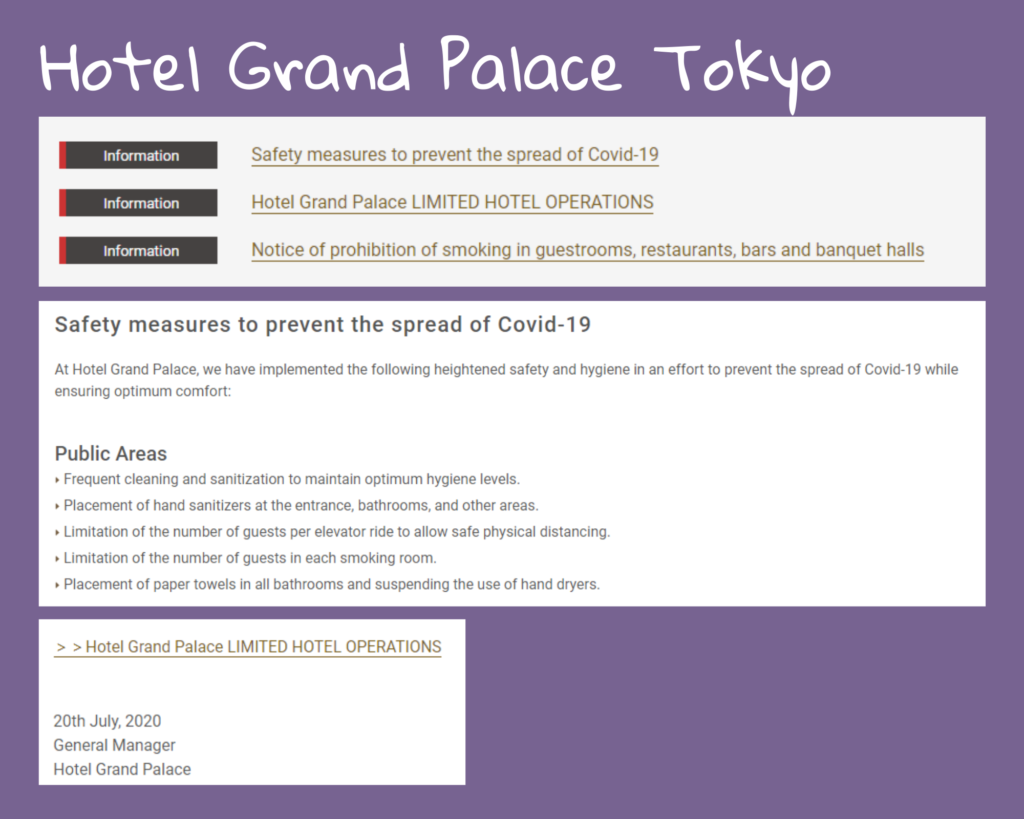
- Personalize the message. You want to sound genuine and human – not like a robot. Signing off with a senior staff member’s name or their position adds a human touch.
- Keep it simple. Short words, short sentences and short paragraphs work best. You don’t want to overwhelm or discourage people from reading further.
- Link to other relevant information. This is a good opportunity to highlight other important updates, such as temporary closures, reduced operations, or changes to service hours that potential guests should know.
NH Hotels: Feel safe at NH
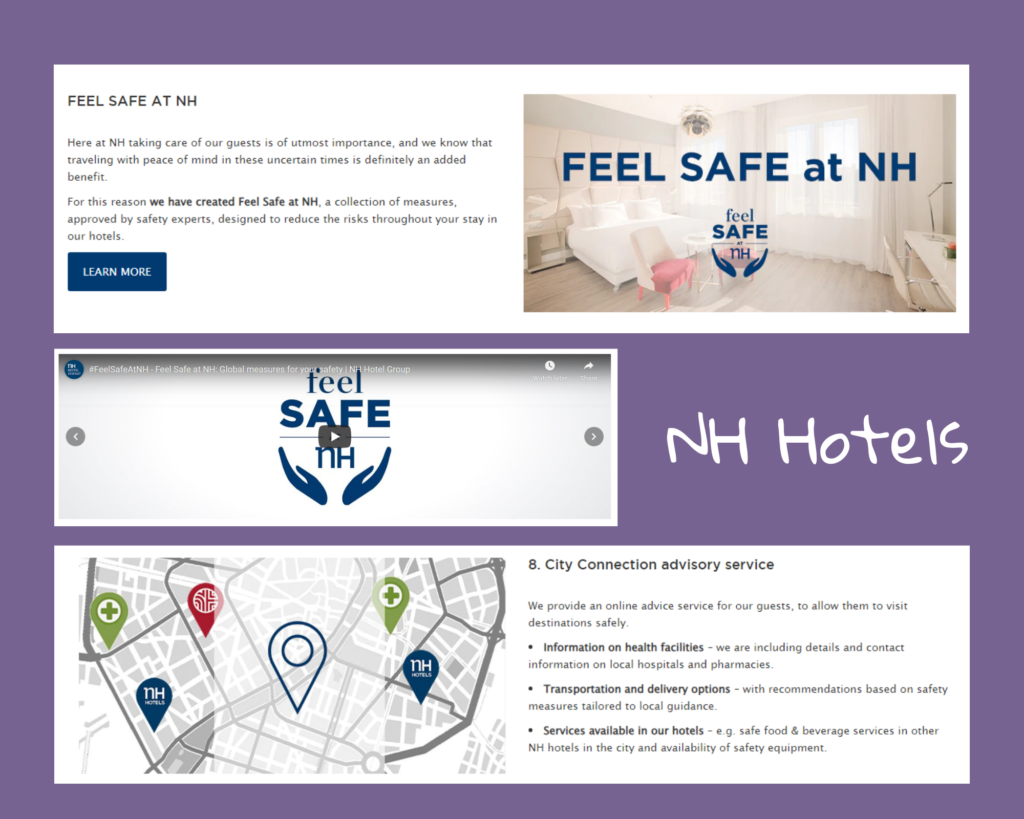
- Take advantage of video. Videos get your message across in an interactive manner. They also offer an alternative to reading lengthy text.
- Address other potential concerns ahead of time. Inform would-be guests that you will provide them with additional practical information like English-speaking pharmacies or nearby medical facilities. Such details can further relieve travel-related anxieties.
- Use positive terms. How you frame a message can impact how it’s perceived. Don’t be all doom and gloom. Positive words and phrases will land better than those that incite fear.
Hard Rock Hotels: Post COVID-19 holidays with Hard Rock Tenerife
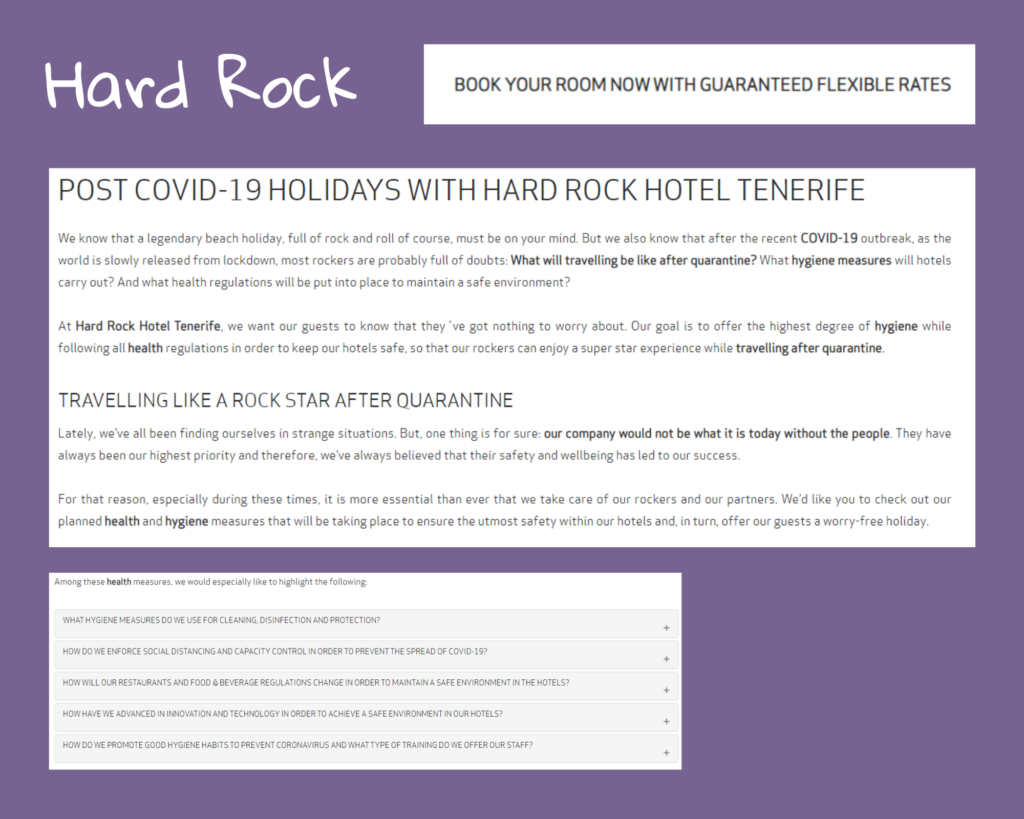
- Use an appropriate tone. Keep your brand voice consistent but adjust the tone of your hotel COVID-19 safety message.
- Incorporate a drop-down Q&A feature. The page should be easy to scan. Adding a Q&A feature allows readers to read about the topics or areas of concern that matter to them most.
- Add a relevant call to action. Now that prospects have read the hotel COVID-19 safety measures, it’s time to tell them what to do next. Choose your words wisely. This is your chance to move them along the travel purchase journey.